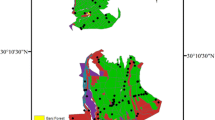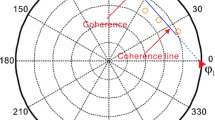Abstract
The concepts of critical baseline and maximal effective baseline have been defined for interferometric SAR (InSAR) DEM application based on the spatial decorrelation (which is a function of baseline). This paper puts forward these two concepts to polarimetric interferometric SAR (Pol-InSAR) forest height estimation application. The application makes use of volume decorrelation, which is also a function of baseline. So both the spatial decorrelation and volume decorrelation are considered to determine Pol-InSAR critical and maximal effective baseline. Firstly various decorrelation effects are discussed. Then the calculation formula of Pol-InSAR maximal effective baseline are presented and compared to that of InSAR. For validation, RVoG-based and PolSARpro-based simulation data and DLR ESAR data are used. The concept of Pol-InSAR maximal effective baseline is of practical significance in selection of Pol-InSAR image pairs as well as in the design of further Pol-InSAR systems.
Similar content being viewed by others
References
Rosen P A, Hensley S, Joughin I R, et al. Synthetic aperture radar interferometry. P IEEE, 2000, 88: 333–382
Lee J S, Pottier E. Polarimetric Radar Imaging: from Basic to Applications. Boca Raton: CRC Press, 2009. 66–73
Cloude S R, Papathanassiou K P. Three-stage inversion process for polarimetric SAR interferometry. IEE P-Radar Son Nav, 2003, 150: 125–134
Lopez-Sanchez J M, Ballester-Berman J D, Marquez-Moreno Y. Model limitations and parameter-estimation methods for agricultural applications of polarimetric SAR interferometry. IEEE Trans Geosci Remote, 2007, 45: 3481–3493
Schneider R Z, Papathanassiou K P, Hajnsek I, et al. Polarimetric and interferometric characterization of coherent scatterers in urban areas. IEEE Trans Geosci Remote, 2006, 44: 971–984
Zebker H A, Villasenor J. Decorrelation in interferometric radar echoes. IEEE Trans Geosci Remote, 1992, 30: 950–959
Gatelli F, Guarnieri A M, Parizzi F, et al. The wavenumber shift in SAR interferometry. IEEE Trans Geosci Remote, 1994, 32: 855–865
Chang Z, Zhang J, Gong H, et al. ’Maximal effective baseline’ for conventional SAR interferometry. Int J Remote Sens, 2007, 28: 5603–5615
Cloude S R, Papathanassiou K P. Polarimetric SAR interferometry. IEEE Trans Geosci Remote, 1998, 36: 1551–1565
Treuhaft R N, Siqueira P R. Vertical structure of vegetated land surfaces from interferometric and polarimetric radar. Radio Sci, 2000, 35: 141–177
Mette T, Kugler F, Papathanassiou K P, et al. Forest and the random volume over ground — nature and effect of 3 possible error types. In: 6th European Conference on Synthetic Aperture Radar. Berlin: VDE Verlag GmbH, 2006. 1–4
Krieger G, Papathanassiou K P, Cloude S R. Spaceborne polarimetric SAR interferometry: performance analysis and mission concepts. Eurasip J Appl Signal Proc, 2005, 20: 3272–3292
Papathanassiou K P. Polarimetric SAR interferometry. PhD Dissertation. Graz: Technical University Graz, 1999. 72–74
Lee J S, Hoppel K W, Mango S A, et al. Intensity and phase statistics of multilook polarimetric and interferometric SAR imagery. IEEE Trans Geosci Remote, 1994, 32: 1017–1027
Papathanassiou K P, Moreira J R. Interferometric analysis of multifrequency and multipolarization SAR data. In: International Geoscience and Remote Sensing Symposium. Vol 2. Piscataway: IEEE, 1996. 27–31
Treuhaft R N, Madsen S N, Moghaddam M, et al. Vegetation characteristics and underlying topography from interferometric radar. Radio Sci, 1996, 31: 1449–1485
Papathanassiou K P, Cloude S R. Single-baseline polarimetric SAR interferometry. IEEE Trans Geosci Remote, 2001, 39: 2352–2363
Zhou Y S, Hong W, Wang Y P, et al. Baseline analysis of polarimetric SAR interferometry. In: Wu S J, ed. Asian and Pacific Conference on Synthetic Aperture Radar. Vol 1. Piscataway: IEEE, 2007. 185–188
Zhou Y S, Hong W, Cao F, et al. Analysis of temporal decorrelation in dual-baseline PolInSAR vegetation parameter estimation. In: International Geoscience and Remote Sensing Symposium. Vol 2. Piscataway: IEEE, 2008. 473–476
Author information
Authors and Affiliations
Corresponding author
Rights and permissions
About this article
Cite this article
Zhou, Y., Hong, W., Wang, Y. et al. Maximal effective baseline for polarimetric interferometric SAR forest height estimation. Sci. China Inf. Sci. 55, 867–876 (2012). https://doi.org/10.1007/s11432-011-4398-1
Received:
Accepted:
Published:
Issue Date:
DOI: https://doi.org/10.1007/s11432-011-4398-1




